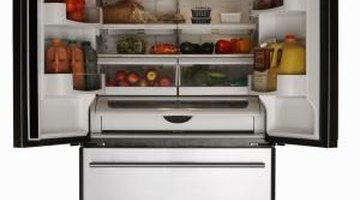Indoor Refrigerator Vs. Outdoor Refrigerator
A refrigerator runs continuously: 24 hours a day, 7 days a week, 365 days a year. It must be able to withstand certain elements in its environment so as to run properly and preserve food and beverages. However, there are different types of refrigerators for different spaces, such as an indoor or outdoor refrigerator. When choosing a refrigerator, it is important to weigh the similarities and differences, so as to not put the wrong type of refrigerator in a specific environment.
Indoor Refrigerators

Indoor refrigerators, or fridges, cannot be brought outdoors no matter what the circumstance. They are not designed to properly and safely run in an outdoor environment, making them a safety hazard if placed outdoors. They cannot stand up to outdoor elements including rain, excessive heat, condensation or excessive cold. Indoor refrigerators come in a variety of sizes, shapes and colors. In terms of customization, these refrigerators come in thousands of different styles, including brightly colored retro styles, that can be purchased for use in the home.
Outdoor Refrigerators
Outdoor refrigerators are specifically designed for use in outdoor spaces, such as on a patio or in an outdoor kitchen or kitchenette. However, unlike an indoor refrigerator, these could potentially be brought indoors for use and still continue to function properly. In fact, some companies today even manufacture combination indoor/outdoor refrigerators that are safe for use in both environments.
Similarities
Both indoor and outdoor refrigerators can be either built in to a kitchen area or they can be a freestanding appliance. Both are available in a multitude of colors, including the most common shades of white, black or stainless steel. Each come in a variety of sizes, including small under-counter options and larger sizes for entertaining. Indoor and outdoor refrigerators both work to keep food and beverages at an ideal temperature. In relation to price, both refrigerators can be found for as low as around $500 and cost upwards of several thousand dollars depending on the make, model, size and other features of the chosen fridge.
Differences
An outdoor refrigerator is designed to better deal with the constant fluctuations in temperature due to the weather; whereas an indoor refrigerator does not have to work as hard to deal with temperature changes, as indoor temperatures tend to stay relatively the same. Outdoor fridges are also better able to deal with the elements and remain working safely regardless of the outdoor weather. Outdoor refrigerators also contain more insulation to better protect their contents from unstable weather conditions. Indoor refrigerators, however, tend to have more features. For example, they may feature built-in TV screens or ice dispensers, whereas an outdoor refrigerator generally comes with the basics: adjustable shelves, adjustable thermostat and an interior light.
References
Photo Credits
- Ryan McVay/Photodisc/Getty Images
More Articles



